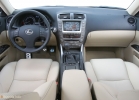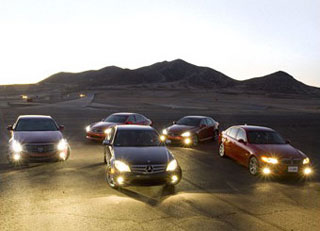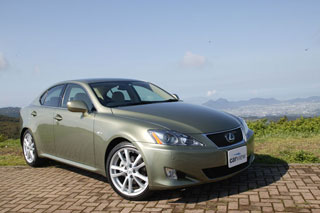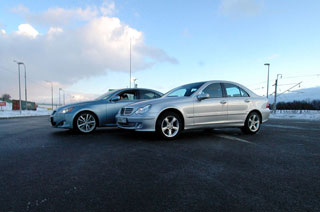Lexus is test drive since 2005 sedan
Lexus IS350 Version L car overview
 Technical characteristics Lexus IS350
Technical characteristics Lexus IS350 The size of the body (length / width / height) 4575 mm / 1795 mm / 1430 mm.
Wheel base 2730 mm
Car weight 1610 kg
FR drive (rear -wheel drive)
The engine 3.5-liter, 6-cylinder with the V-shaped cylinders, the gas distribution mechanism two upper shafts, the developed power of 318 hp. at 6400 rpm, the largest torque is 38.7 kg/m at 4800 rpm.
Transmission 6-speed automatic transmission
The price of the car is 5.250,000 yen (about $ 52,000)
Cool v6 can be made super
In order to make an idea of \u200b\u200bthe Lexus IS model range, I decided to try several cars in turn at once: the IS250 of the category L, then the IS 350 car of the category S, and, finally, IS350, but only categories of L. Machines designated as version l , were equipped with 17 -inch wheels, as for the version of S, this machine is put on wheels of 18 inches.
The starter switch, as on all models of the Lexus family, is a button type, is located to the left of the steering column. It is likely that the model, which is planned to be released on the Japanese market next year, that is, Lexus LS, will also be equipped with a similar start -up switch. I decided to start introductory travels with the IS250 model. What are its speed characteristics? Cold: maximum developed power of 215 horsepower, torque 26.5 kg/m. This is not to say that this is a low -power model, although you can’t call it super -powerful either. In a sense, it can be argued that in this particular
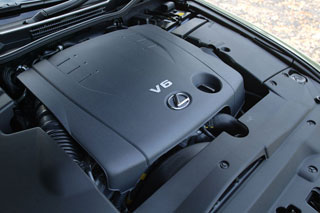 case of a subjective sense of power from direct control of the car almost completely corresponded to the preliminary assessment, which you will be issued by the willy-nilly whenever you get acquainted with the technical data of the new machine. No, there is no need to expect explosive acceleration from this car, although on the other hand, when driving along a flat straight road, you just need to press the accelerator on the pedal, and the car obediently, and most importantly, will quickly execute the command. It is also impossible not to note the smooth rotation of the crankshaft and the noiselessness of the working engine. Of course, if you evaluate the engine of the machine by how evenly the torque is distributed throughout the operating speed range, and if you take into account how the engine behaves at transcendental speeds, then it will be necessary to admit: the IS250 model does not reach the IS350 level. But, on the other hand, if you do not belong to the category of drivers who are required only such a car, the speed qualities of which are recognized as the standard, the IS250 model should well arrange you. And all the conversations are in the sense that, they say, she doesn’t get something, whether it is smooth rotation, or, say, the necessary timbre of sound from a working engine, all this is nothing more than emotions. Compared to the same Straight 6 motor from BMW, there is no inhibitory (in the positive sense of the word), the engine makes a light whistling sound that may seem too dry for someone. If, for example, before that, the driver dealt mainly with Toyota cars, then he is unlikely to have any negative emotions. Yes, and where do they come from, if, for example, the Lexus GS model is eighty percent of the same Toyota Aristo! But if a person who is used to the prestigious European brands of cars sits behind the wheel of the Lexus IS250, then it cannot be ruled out that some moments will not appeal to him.
case of a subjective sense of power from direct control of the car almost completely corresponded to the preliminary assessment, which you will be issued by the willy-nilly whenever you get acquainted with the technical data of the new machine. No, there is no need to expect explosive acceleration from this car, although on the other hand, when driving along a flat straight road, you just need to press the accelerator on the pedal, and the car obediently, and most importantly, will quickly execute the command. It is also impossible not to note the smooth rotation of the crankshaft and the noiselessness of the working engine. Of course, if you evaluate the engine of the machine by how evenly the torque is distributed throughout the operating speed range, and if you take into account how the engine behaves at transcendental speeds, then it will be necessary to admit: the IS250 model does not reach the IS350 level. But, on the other hand, if you do not belong to the category of drivers who are required only such a car, the speed qualities of which are recognized as the standard, the IS250 model should well arrange you. And all the conversations are in the sense that, they say, she doesn’t get something, whether it is smooth rotation, or, say, the necessary timbre of sound from a working engine, all this is nothing more than emotions. Compared to the same Straight 6 motor from BMW, there is no inhibitory (in the positive sense of the word), the engine makes a light whistling sound that may seem too dry for someone. If, for example, before that, the driver dealt mainly with Toyota cars, then he is unlikely to have any negative emotions. Yes, and where do they come from, if, for example, the Lexus GS model is eighty percent of the same Toyota Aristo! But if a person who is used to the prestigious European brands of cars sits behind the wheel of the Lexus IS250, then it cannot be ruled out that some moments will not appeal to him. The IS350 model is truly high-speed! Of course, if the engine develops a power of 318 hp. And a torque of 38.7 kg per meter, then it is quite reasonable to count on the fact that even a slight pressing on the accelerator pedal will not go unnoticed. Even if at the same time the engine already works at maximum speeds. But if you press the gas pedal even deeper? Then the engine will begin to make a sound impressive in the timbre, which will not be tedious, even if the car will follow at full speed for a long time. On the contrary, it is such noise accompaniment that is extremely desirable for such machines. And if you still remove a slightly confused noise at transcendental revolutions, if the rotation was listened a little more clearly, then, I am sure that this 6-cylinder engine with a V-shaped location of the cylinders could become a real super-class unit. It may well be that if you separately consider such components of a high -quality motor as the content of harmful impurities in exhaust gases, or fuel consumption per unit of mileage, then it already occupies one of the upper lines in the hierarchy of world -class engines. At least if you put it on the Toyota brand model, it is completely out of criticism! But in this case we are talking about the Lexus brand. And this obliges a lot.
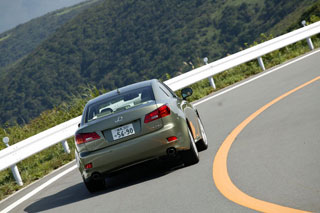 The logical circuit of the automatic gearbox should be finalized
The logical circuit of the automatic gearbox should be finalized As already noted, the automatic transmission installed on the Lexus IS model has 6 speeds and manual switching mode. This type of automatic gearboxes produced by AISHIN, with a short working move of the switching lever, has already established itself well on other models produced by the Toyota concern. But, given the sports specificity of the machines, like, say, the Lexus IS350, you should consider the variant of the gearbox selected by the designers not in everything and not ended with the end. The direct lock and hardware system does not cause special complaints. But here, with regard to control software, here everything is again, in the previous machines of the Toyota brand. But we are talking about the Lexus car! What exactly do I mean? I'll try to explain in a nutshell. So, it is presumably that in a car of a similar class, the gearbox should, on the one hand, provide a certain level of security, and on the other hand, give the driver a maximum of driving pleasure. So, in this particular case, pleasure, it seems to me, was decided to sacrifice, and give preference to give safety. In fact, if the engine develops such a torque as on the Lexus IS250, not to mention its collection IS350, then it would be quite acceptable to expand the engine speed, when the clutch discs in the hydraulic coupling adheres tightly, and the gap when there is a friction of the discs reduce. In this case, I am sure that the potential that was originally laid in the engine could be used with greater benefit. And so, it is unfortunate that in the sporting in essence, there is no mechanism for coordinating the revolutions when switching to a reduced gear.
And the most important question: why can the gearbox still be made to jump for reduced gear by just pressing the pedal, and at the same time calmly go in the chosen manual mode? For example, the car enters the turn at third speed. And at the exit from the turn, the driver sharply presses the accelerator to gain speed within the same third gear. But instead, please, the box abruptly includes the second gear. From this, of course, the torque transmitted to the wheels increases sharply. And after this, the VDIM system comes into action in order to prevent the machine from losing stability. In terms of safety, everything seemingly correctly, but only the maneuver itself will not give the driver the expected pleasure. In theory, in such a scheme there would be a function that controls the switching of the box to a reduced gear. For example, it would be possible to increase the stiffness of the accelerator pedal, so that the driver could feel how much you can increase gas without risk to move for low gear. And then, if the driver considered it necessary to overcome this line, then, by logic, a low gear should turn on. I believe that the installation of such a restrictive device would be quite appropriate. On the other hand, if you use manual switching keys, then an automatic transition to increased gear does not occur, even if the engine speeds reach the maximum level, which is marked on the tachometer with a red line. If the gearbox control lever is in position D, then the keying switching is completely blocked. This solution does not look entirely true, because you never know what the driver can be required. For example, slightly slow down with the engine, or just with a light movement of the hand, switch to a low gear. This is impossible on the described machine.
 By the way, in all Western models, and if you take Japanese machines, then in the Subaru lineup, temporary inclusion of manual switching mode at the moment when the transmission control handle is in position D is provided. True, the time of action of the manual switching mode is limited, and when it expires, the transmission again returns to mode D (automatic switching). In a word, my opinion is as follows: if the car really claims to be truly sports, then the logical scheme of automatic switching should be finalized.
By the way, in all Western models, and if you take Japanese machines, then in the Subaru lineup, temporary inclusion of manual switching mode at the moment when the transmission control handle is in position D is provided. True, the time of action of the manual switching mode is limited, and when it expires, the transmission again returns to mode D (automatic switching). In a word, my opinion is as follows: if the car really claims to be truly sports, then the logical scheme of automatic switching should be finalized. Do you want the car to be the driver in joy only from high -quality materials!
The suspension should be evaluated for all five. I will say more: I was just amazed, and for this it was not necessary to go far. It was enough only to move. Moreover, it doesn’t matter to what size the rubber is shod the wheel of the machine, the size of 17 inches, or 18 inches. The main thing is that the driver immediately feels how thoroughly the car is on the ground, and how firmly the tires hold on to the road surface. Perhaps in the previous models that came out under the Toyota brand, such thoroughness, I have never experienced such sensations. The suspension began to cut the irregularities of the road already at low speeds. And then the speed began to grow, but the feeling of constant contact of the wheels with the road did not disappear. This is not to say whether the suspension works hard, or whether it has an emphasized soft character, this kind of assessment is not suitable. The main thing is that her work gives the driver a feeling of increased stability and, accordingly, spurks to choose a more active driving manner. And at the same time, we can accurately determine that all this is borrowed from Toyota cars. It is possible that such a suspension work is a consequence of additional refinement. But I think that this is based on the use of rod stability of a larger section. The levers of such a thickness on other cars, produced by Toyota, I have never met. The engineers who conduct the Lexus project, just like those who work for the Toyota brand, are tirelessly repeating that they say, the main thing is not in money, and most importantly in the ingenuity. But I will allow myself to doubt the sincerity of these words. In fact, to prepare a delicious dish, it is not enough just to know how to do it. It is also important to use quality products. So it is: no matter how good the development was, but without the use of expensive materials, nothing from the comfortable in terms of comfort would have happened. In any case, the impression is that when developing vehicles of the Lexus IS lineup, the question of costs, if it stood, is far from in the foreground.
The operation of the steering is also worthy of flattering assessments. As already noted, the steering mechanism amplifier has an electric drive, but this almost does not cause any negative emotions. And where did they come from, if, firstly, the steering wheel rotates smoothly, and secondly, most importantly, the car clearly reacts to the steering team, which allows the car, as they say, along the thread. If even the speed of movement begins to increase, if the car goes to the site abounding with turns, the feeling of unity with the machine does not disappear, as well as a sensation of a high degree of trust of the driver to the controlled car. But in the end, those drivers whose experience is not in doubt, and those who have only superficial driving skills, everyone feels behind the wheel of a car real professionals. But is this not a sure sign that driving will deliver joy to anyone who is driving?
I choose IS! But what kind of model?
One of the few, but significant, from my point of view of the points, which should be thought by the designers of the Lexus model, concerns the quality of tire adhesion with the road in those areas where it abounds with numerous tubercles and potholes. In particular, if the car goes to such a section of the road where there is small ripples, or the same potholes, and continues to move with increased speed, then the lower side of the springs ceases to follow irregularities and begins to work randomly. I will try to express myself figuratively so that my thought becomes clear. So, the lower back is held tightly, the knees swing slightly, and the hip joints have not yet been developed, and therefore are not elastic. What will happen in this case if you apply sharp braking? Is this, for example, to act ABS? That's right, the braking distance will increase, and the car itself will largely cease to obey the steering wheel. To prevent this from happening, these same hip joints need to stir up, so that they allow the feet to always and everywhere follow the irregularities of the road. And then the controllability of the machine in such uneven sections of the road will become much better.
But that's not all. If in the middle of the turning to turn on the brakes at full power, then the front part will instantly go in the direction opposite from the turning center, and the car will lose control. To prevent this from happening, the ABS system begins to dump hydraulic pressure in the brake system. And all that would be nothing, but only in this case the braking moment is not at all the same as the driver was counting on. This is the second point on which the appropriate changes should be made. And if all these shortcomings are eliminated, then the suspension of the IS lineup may well compete with the BMW 3 Series or Mercedes Class cars.
Now about the fact that the car of the same category (L) is on 17-inch wheels, and the other (category S) will be shod in 18 inches tires. Of course, in appearance, and in terms of the level of grip of the wheels with the road, the second option seems preferable. And at the same time, if you pull 18-inch tires on the wheels, the driver clearly feels sharp blows at high joints of the road surface. Try, however, to overcome the same joints, but already on 17-inch tires. Blows will be felt, but already from a different angle, and therefore, not so acute. And since it was not possible to find any other significant differences, I would personally give preference to the option with 17-inch tires, as more balanced in terms of suspension. So, if I, a journalist Okazaki Gorod, decided to buy a Lexus IS car, then I would probably choose an IS350 model with 17-inch wheels, since it is this option, it seems to me that the most successful element of sports and everyday life. And, therefore, on it you can not only perform sports races, but also use it for everyday trips.
Source: CarView.co.jp
Lexus IS crash tests since 2005
Lexus is test drive since 2005
Lexus IS Crash Test since 2005
Krassh Test: Detailed Information33%
Driver and passengers
15%
Pedestrians
39%
Children-passengers



